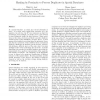Free Online Productivity Tools
i2Speak
i2Symbol
i2OCR
iTex2Img
iWeb2Print
iWeb2Shot
i2Type
iPdf2Split
iPdf2Merge
i2Bopomofo
i2Arabic
i2Style
i2Image
i2PDF
iLatex2Rtf
Sci2ools
CIKM
1994
Springer
1994
Springer
Hashing by Proximity to Process Duplicates in Spatial Databases
In a spatial database, an object may extend arbitrarily in space. As a result, many spatial data structures e.g., the quadtree, the cell tree, the R+-tree represent an object by partitioning it into multiple, yetsimple, pieces, each of which is stored separately inside the data structure. Many operations on these data structures are likely to produce duplicate results because of the multiplicity of object pieces. A novel approach for duplicate processing based on proximity of spatial objects is presented. This is di erent from conventional duplicate elimination in database systems because, with spatial databases, di erent pieces of the same object can span multiple buckets of the underlying data structure. Example algorithms are presented to perform duplicate processing using proximity for a quadtree representation of line segments and arbitrary rectangles. The complexity of the algorithms is seen to depend on a geometric classi cation of di erent instances of the spatial objects. By ...
Related Content
| Added | 09 Aug 2010 |
| Updated | 09 Aug 2010 |
| Type | Conference |
| Year | 1994 |
| Where | CIKM |
| Authors | Walid G. Aref, Hanan Samet |
Comments (0)

